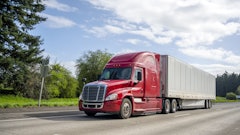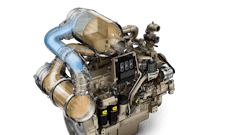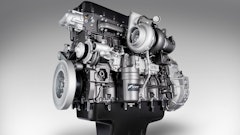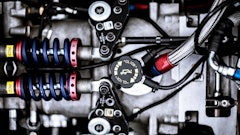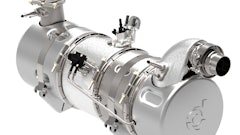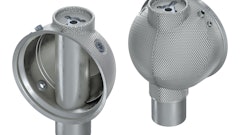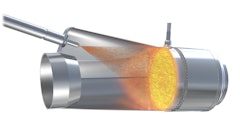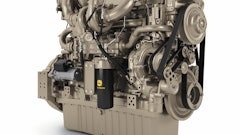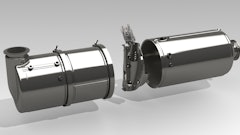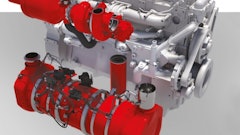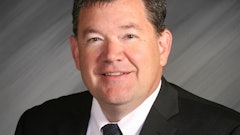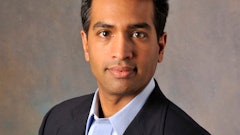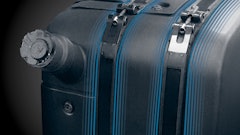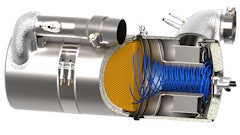SCR or non SCR? That's the fork in the road engine manufacturers face as they gear up to meet the Tier 4 (European Stage III B) emissions regulations slated to take effect in 2011.
There are two different paths to take to achieve the strict emission standards, which require a 90% reduction in diesel particulates and a 50% reduction in NOx emissions for engines greater than 174 hp (130 kW).
The first approach utilizes selective catalyst reduction (SCR) technology. Urea — a liquid-reductant agent — is injected into the exhaust gases as they enter a catalyst that causes the urea to convert NOx emissions into nitrogen and water. The second approach expands the use of exhaust gas recirculation (EGR), adding diesel oxidation catalysts and diesel particulate filters to treat the exhaust gases.
Both approaches have their challenges. Companies that elect the non-SCR route must deal with increased heat rejection and reduced fuel economy. There is also concern that this path will ultimately be a technological dead-end as emission regulations become increasingly severe.
Companies that take the SCR path, on the other hand, must deal with the challenges of adding more equipment, implementing new technology and electronic controls, and keeping urea from turning to frozen slush around 12 F. They're also gambling that enough urea will be available nationwide. For their efforts, however, they get an engine that has better fuel economy and performance.
Although the stricter emissions standards are still two years away, engine manufacturers are staking out their technological paths today. "We used to make announcements a year out," says Tom Withers, a Deere spokesperson. "Now, we are announcing much further out. We are identifying our chosen path and will then spend the next two years designing and developing along that path."
Engine manufacturers choose
John Deere is pursuing the non-SCR route. It will refine the high-pressure fuel injection, cooled EGR and variable geometry turbochargers on its Tier 3 PowerTech Plus engine platform and add diesel oxidation catalysts and diesel particulate filters to treat exhaust gases. Deere has not ruled out using SCR to meet the final Tier 4 standards in 2014, provided that certain issues are addressed, including the availability of urea and the technology needed to use it.
Caterpillar is also choosing the non-SCR route, electing to build on its ACERT technology with oxidation catalysts and diesel particulate filters. It has also announced plans to introduce a new 7-liter engine designed specifically to meet Tier 4 interim and future emissions standards.
Of all the major engine manufacturers, Caterpillar has shown the least interest in SCR technology. While SCR is almost universally accepted as the technological solution for the on-highway market, Caterpillar has elected to pull out. Instead, it plans to team up with Navistar to develop, manufacture and distribute non-SCR solutions outside of North America.
Cummins is also pursuing the non-SCR route. Its "core technology" will rely on the use of diesel particulate filters and EGR. Engine enhancements will include variable geometry turbochargers, advanced electronic controls and high-pressure, common-rail fuel systems.
Choosing SCR
MTU Detroit Diesel, on the other hand, has elected to employ SCR systems on its Series 900 and Series 500 engines, because it believes SCR will be the standard technology when the final Tier 4 standards take effect in 2014.
AGCO Corp. will be working with engines using both SCR and non-SCR technologies, but has elected to utilize SCR technology for its Sisu engine line.
"Massey-Ferguson is already using SCR technology to meet Tier 3 standards in Europe," says Barry O'Shea, product manager, North American HHP tractors. "With SCR, you get a cleaner result and better fuel economy. You also don't have heat-rejection problems, which can be an issue when you are using equipment to cut fields."
O'Shea noted that in order to meet Tier 3 standards, engine manufacturers adjusted engine timing and added EGR, which reduced fuel economy. "With SCR, we can go back to Tier 2 technology where there is no EGR. We can also return engine timing back to where it should be."
O'Shea is not concerned about the need to add a tank to store the urea. Nor is he worried about the availability. "We plan to distribute [urea] through our dealer network," he says. "We think you will see other distribution networks take off as soon as on-highway (2011 standards) come online."
The distribution challenge
Again, O'Shea points to Europe, which has already established a distribution for AdBlue, its urea product. The distribution for a similar product in the U.S. — diesel exhaust fluid (DEF) — is just now being developed for the on-highway market by truck manufacturers, fuel facilities, fuel distributors and urea providers.
The network will need to be in place by 2010 to meet on-highway standards, and if it is, expanding the distribution network to the off-highway market should be relatively straightforward.
"Although additional logistical steps are required to transport urea to nonroad equipment worksites, the nonroad demand for urea will not strain the expected urea supply or distribution system needed," says Jed Mandel, president of the Engine Manufacturers Assn., which commissioned a study on urea supply.
"The results of the analysis assure manufacturers and EPA that urea supply issues are not a stumbling block in the utilization of SCR in nonroad engines and equipment."
Dave Jensen is a contributing editor based in Milwaukee, WI.




